This was the article I did for APQS to be published...There have been a few of you that have asked to see it and I sent you over to the APQS site, but thought I would copy it to here for you all to read it easier. This was so much fun to be asked to right an article and have it published. Thank you for the support and enjoy!!There are several pictures so I am hoping they came across
Editor’s note: Today’s post about pantograph and free motion quilting was written by guest blogger Machelle Sterkel. Machelle has been quilting for 15 years and has had her Millennium longarm machine for 4 years. She is based in Nebraska/Wyoming and shares her quilting stories on her blog CreativeQuiltingWithLove.blogspot.com. Thank you, Machelle.
As a novice quilter, one of the hardest things to figure out is whether to use a pantograph for your quilting, or use the free motion approach.
Before we get into the advantages and disadvantages of either approach, let’s review what pantograph and free motion quilting is.
Here are some examples of free motion quilting:
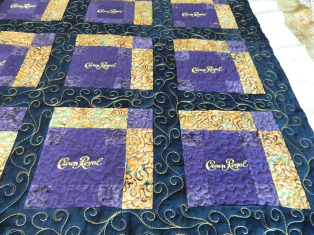
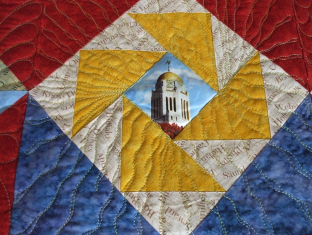
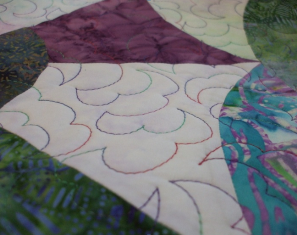
When quilting in this manner you will place the paper pantograph on a table attached to the back of the quilting frame, and a laser light is fastened to the machine. You will then move the machine across the pattern using the laser light as your guide. Pantographs are a great way to build confidence in your quilting!
Here are some examples of pantograph quilting:
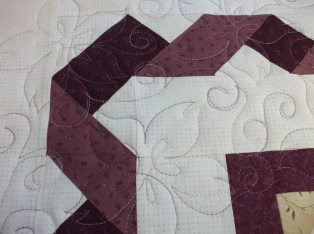
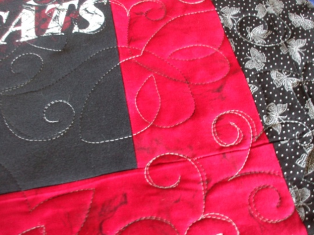
I have found there are pros and cons to both pantographs and free-motion quilting. Personally, I prefer free motion quilting, because I like all the quilts I create to be unique for each customer. If I were to pantograph all the quilts I work on, then many of them would have the same design on them and would not be unique.
Free motion quilting gives me the freedom to design each top with unique motifs. I just start moving the machine and I come up with something different each time. Although free motion does leave each quilt with a different motif, an advantage of pantographs is that quilt tops always seem to look "perfect” when using them.
If you have a hard time coming up with a motif to quilt on your own then a pantograph is a perfect solution. You can make your own or purchase ones that resonate with you. Several companies carry pantographs, and there are some really nice pantographs on the market. I prefer the pantographs that have partial reference rows above and below the actual complete row I am stitching. These are usually printed in a lighter shade to make it clear they are for spacing purposes. I like this type of pattern because it gives me the ability to roll the quilt to the exact place with the exact spacing between so I don’t get stuck in a corner.
Machelle has been quilting for 15 years and has had her Millennium longarm machine for 4 years. She is based in Nebraska/Wyoming and shares her quilting stories on her blog CreativeQuiltingWithLove.blogspot.com.
Pantograph vs. free motion quilting
March 11, 2014Editor’s note: Today’s post about pantograph and free motion quilting was written by guest blogger Machelle Sterkel. Machelle has been quilting for 15 years and has had her Millennium longarm machine for 4 years. She is based in Nebraska/Wyoming and shares her quilting stories on her blog CreativeQuiltingWithLove.blogspot.com. Thank you, Machelle.
As a novice quilter, one of the hardest things to figure out is whether to use a pantograph for your quilting, or use the free motion approach.
Before we get into the advantages and disadvantages of either approach, let’s review what pantograph and free motion quilting is.
Free motion quilting
Free motion quilting is exactly what it sounds like. It is the free movement of the machine across the quilt top. Many quilters like to compare this type of quilting to drawing on paper. Just imagine that your needle is a stationary pen or pencil, and to draw you have to move your paper (or quilt) beneath it. Free motion gives the quilter the opportunity to show what they can do and the possibilities are literally limitless.Here are some examples of free motion quilting:



Pantograph quilting
Pantographs are quilting patterns that are stitched across the quilt top. The quilting is done from side to side, top to bottom, over the entire quilt without regard to the pieced or appliquéd design of the top.When quilting in this manner you will place the paper pantograph on a table attached to the back of the quilting frame, and a laser light is fastened to the machine. You will then move the machine across the pattern using the laser light as your guide. Pantographs are a great way to build confidence in your quilting!
Here are some examples of pantograph quilting:


I have found there are pros and cons to both pantographs and free-motion quilting. Personally, I prefer free motion quilting, because I like all the quilts I create to be unique for each customer. If I were to pantograph all the quilts I work on, then many of them would have the same design on them and would not be unique.
Free motion quilting gives me the freedom to design each top with unique motifs. I just start moving the machine and I come up with something different each time. Although free motion does leave each quilt with a different motif, an advantage of pantographs is that quilt tops always seem to look "perfect” when using them.
If you have a hard time coming up with a motif to quilt on your own then a pantograph is a perfect solution. You can make your own or purchase ones that resonate with you. Several companies carry pantographs, and there are some really nice pantographs on the market. I prefer the pantographs that have partial reference rows above and below the actual complete row I am stitching. These are usually printed in a lighter shade to make it clear they are for spacing purposes. I like this type of pattern because it gives me the ability to roll the quilt to the exact place with the exact spacing between so I don’t get stuck in a corner.
Machelle has been quilting for 15 years and has had her Millennium longarm machine for 4 years. She is based in Nebraska/Wyoming and shares her quilting stories on her blog CreativeQuiltingWithLove.blogspot.com.